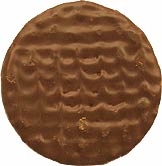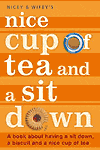Your ViewsKeep your e-mails pouring in, it's good to know that there are lots of you out there with views and opinions. To help you work out what is what, are now little icons to help you see biscuit related themes. And now you can see at a glance which are the most contested subjects via this graph (requires Flash 6.0 plugin). Please keep your mails coming in to nicey@nicecupofteaandasitdown.com | If you like, you can use this search thingy to find stuff that matches with any of the icons you pick, or use the fantastic free text search, Yay! | Your e-Mails |
| Romie Stott |
Dear Nicey,
I just read your e-mail from Richard with regards to the foolhardy practice of adding milk to tea before the water, leading to a very weak cuppa. You both theorized that the milk formed some kind of protective barrier around the leaves and or bag, such that the tea was unable to break free. I suspect the explanation is much more simple: the milk was cold, or at least colder than the piping hot water that comes out of the kettle. The tea didn't brew properly because the milk cooled the water before it reacted with the tea (heat being one of the best ways to get a solution to supersaturate). If Richard is really attached to this method, he might try to find "iced tea" tea bags, which are specially formulated to brew in room-temperature water, but he's probably better off just adding the milk afterward.
Regards,
Romie Stott
P.S. On the subject of iced tea, Steve's e-mail about the flask-brewed Indian-style teas made me think of sun tea. Clearly there must be some chemical reaction process on which causes tea to eventually un-stew and turn into something new and palatable, a bit like the juice-wine-vinegar or milk-curdled milk-cheese continuum. I hope you will speak to the highest members of government about funding an investigative panel of top scientists. |
| Nicey replies: We have had a few replies about the temperature being lowered by the milk. So I've just tried experimenting with a tea bag in some cold water, then pouring in the boiled water. The tea bag took a little longer to get going, I think because the leaves had clumped together a bit in the cold water. After a few stirs everything appeared to be proceeding as normal. When it had all reached the right colour I added the milk. I was genuinely surprised to find that it tasted wrong, sort of flat and dull with something missing.
So its my conclusion that its not the temperature of the final brew that is the is the issue, a few degrees here or there is not going to greatly affect things. After all I've produced much better cuppas with water that hadn't just been boiled when forced to by circumstance. It is however crucial that the dry leaves are hydrated with boiling, (or as near to as you can get) water. I suspect once again, as we have discussed in the past with regard to tea stewing, it's got something to do the structure of the cell walls in the dried tea leaves and how they allow the passage of solutes. I would hypothesise that the cold water/milk sets the tea leaf into a different configuration to that of boiling water, and that this is not undone by the subsequent addition of boiling water.
Also, grotty as this cup of tea was, it was not as woeful as if I had added milk first. I still suspect that the droplets of fat in the milk will adhere and smother the tea leaves providing them with patches of water proofing. The casein protein in the milk is also bound to shake things up at a molecular level, weakly bonding with this that and the other and denaturing as the boiling water arrives.
As to top scientists investigating, they probably already have but can't reveal their results for fear of causing mass hysteria in the populace. |
| |
Matt Youson

McVities Milk Chocolate Digestive Review |
Dear Nicey
Can you help solve a dispute that is bitterly dividing my office?
In an episode of the classic 1974 children's TV series Bagpuss, the mice in the mouse organ claim to be making chocolate biscuits "from butterbeans and breadcrumbs." Half the office distinctly remember the biscuits in question being chocolate digestives, the other half are convinced they were Jaffa Cakes. Having studied footage on YouTube, the digestive argument has been pretty much shot out of the water, the new debate is whether the biscuits used are Jaffa Cakes, Viscounts or some as yet unknown 1970s alternative.
Rather than work in an atmosphere of sectarian distrust and recrimination, we've decided it would be best if we referred the matter to arbitration.
Can you help?
Unfortunately we're working at the Spanish Grand Prix this week and it's too hot to gather our own empirical evidence as it would melt.
Many Thanks
Matt |
| Nicey replies: Yes these things have a habit of cropping up on a Sunday morning at the Spanish Grand Prix. I actually wrote about this very incident in our book in the chapter about Chocolate digestives, as it left a lasting emotional scar of the 'killing of Bambi's mother' variety when I found out that Chocolate Biscuits weren't made from butter beans and breadcrumbs.
Any how with the benefit of archived Bagpuss on YouTube and just my memory to go on I recalled that they were 'Chocolate Biscuits' and therefore chocolate digestives.
The short clip you referred to does have a biscuit with the distinctive pattern in the chocolate as produce by the McVities enrobing process, although in that shot I think the lighting is making it appear a bit domed. I stick with my original memory and the fact that back in 1974 I would have known exactly what sort of biscuit it was, with un-erring accuracy. |
| |
| Richard Morgan |
Dear Nicey.
I made a cup of tea today and made a disturbing discovery. Maybe you or someone else could explain it to me.
I took my cup and placed a teabag into the bottom as usual, but instead of adding the water first I added the milk.
This was tricky as I had to pre-judge the ammount of milk nessesary to make the tea in advance, though this was not my problem at all. The problem was that the milk seemed to smother the tea leaves from within the bag and seriously hinder the performance of the teabag when the hot water was added. It was as if the milk had created a protective barrier around the tea leaves, thus retaining the brown goodness and leaving me with a rather weak cup of tea.
Please try this out and tell me how you get on.
Richard Morgan |
| Nicey replies: Richard,
What you have stumbled over is perhaps one the best known ways of making a really dreadful cup of tea. As such I have no intention at all of subjecting myself to it, having previously been on the receiving end of one or two of those. There are some twisted individuals who actually prefer their tea made in this deviant fashion, and we often cite them as examples of how peoples taste and ideas of what makes a good cuppa vary widely, and as examples of people who don't know how to make tea properly.
I often put this method, if it can be called that, down to a move from instant coffee drinking to tea drinking. I also suspect that they were largely living out a solitary existence, certainly as far as tea making goes when they adopted it. Any sane tea drinker would quickly try and show them the error of their ways. You could get away with it for instant coffee but not for tea.
I think you have made an intuitive evaluation of what's going a wrong. Clearly the milk bungs up the tea leaves and tea bag holes, at some level molecular or microscopic. Whether that is due to lipids or proteins or both I'll leave to your imagination.
In your case perhaps it was some primal hunter-gather type mechanism that kicked in to make you try this iffy tea building. No doubt when we wonder who the curious individual was who thought of eating raw oysters, or decided to eat the really badly gone off milk and call it cheese it was somebody much like yourself. Watch yourself with such idle thrill seeking you'll be moving up to auto asphyxiation next. |
| |
| Steve |
Hi,
I just read your bit in the book about tea in SF and fully sympathise. Was wondering if you have tried tea left in a flask with milk and tea bags for many hours (5?). You would imagine it would come out discustingly stewed, wouldn't you. But it comes out tasting like Chai which was quite a shock for me when my brother introduced it to me a month or two ago, because it reminded me of being in india, where the tea is deliciously sweet and tasty. I thought it was the cloves and other jazz they put in that made it so tasty but now i know its just the fact that its been left to stew for so long (maybe the milk sweetens and turns into something like condensed milk).
Anyways, I've laughed a lot in the last 10 mins reading your book in the toilet of my friends about biscuits, especially the bit about Wagon Wheels, which when I was younger always viewed with disdain because of the soggy biscuit and poor quality ingredients, but then later in life wisened up and learnt to enjoy it as a whole!
happy chai/tea/etc drinking
Steve.
|
| Nicey replies: I heard that in Indian road side truck stops they rate the tea in kilometers depending on how far you have been and how stewed up the tea is, with 500K tea being the thickest.
Personally I'm not consumed with a burning desire to try either tea Chai / Tea made with condensed milk / tea that has been stewed in any way, but I'll defend your right to do so if it comes down to that. Lets end by thinking of a hypothetical situation in which that might happen.
|
| |
| Anne Wilkinson |
I've just discovered your website and am particularly interested in the biscuit info. Do you remember the 'milk and honey' biscuits that used to appear in biscuit selections in the 1950s (or aren't you that old?)? They may have appeared in their own packets too. They were a sandwich biscuit, rather like a custard cream, but oval shaped and with a 'window' in the top layer, which revealed the 'honey' element, which may or may not have consisted of real honey. I'd love to know if they still exist, or when they disappeared.
I totally agree with the pink wafer being the worst biscuit - I can never understand why anyone, ever, eats a wafer biscuit of any sort. What is the reason for the popularity of Kitkat? It's so disappointing. Give me a Club anytime!
Best regards,
Anne Wilkinson |
| Nicey replies: Hello Anne,
The Milk and Honey appears in our missing in action section. We think they didn't make it beyond the 1970s. We have heard tale that it is still produced in the Far East by manufacturers who licensed the biscuit in the 1950s, but have yet to substantiate that.
|
| |
|
|
|




